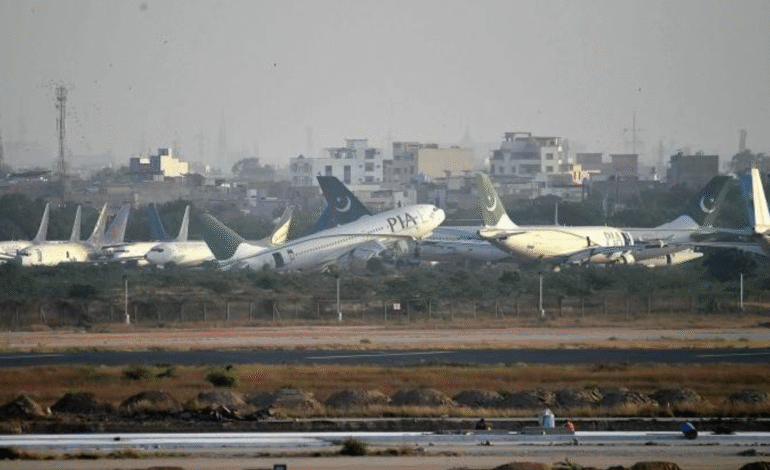Pakistan Reopens Airspace After Ceasefire Agreement with India

In a significant development that marks a de-escalation in the military tensions between India and Pakistan, the Pakistan Airports Authority (PAA) announced the reopening of Pakistan’s airspace on Saturday. The reopening follows a ceasefire agreement between the two countries, mediated by US President Donald Trump. This step comes after several hours of heightened military activity and missile exchanges, which saw Pakistan take retaliatory action against India’s missile strikes on Pakistani airbases.
This move signals a return to normalcy for the aviation industry, which had been severely disrupted due to the escalating military confrontation along the Line of Control (LoC). The reopening of the airspace is a critical development for both civilian and commercial flights, ensuring that travel operations resume smoothly across the country.
Pakistan’s Airspace Reopened for All Flights
According to an official statement from the Pakistan Airports Authority (PAA), the country’s airspace has been fully reopened for all types of flights. This announcement comes after a series of events that saw the closure of Pakistani airspace earlier in the day.
The statement from the PAA confirmed, “Pakistan’s airspace has been fully reopened for all types of flights,” and followed the announcement of a ceasefire agreement brokered by US President Donald Trump. This decision came after Pakistan’s launch of “Operation Bunyan-um-Marsoos,” which was a direct response to missile strikes conducted by India earlier on the same day.
This ceasefire, alongside the resumption of flight operations, marks a crucial turning point in the tense geopolitical situation, with many wondering about the long-term impact on the region’s stability and security.
Ceasefire Agreement After Missiles Strikes
The reopening of the airspace follows a period of intense military activity. On the same day, India had launched missile strikes targeting three key airbases within Pakistan. These attacks were part of escalating tensions, and Pakistan responded with its own military operations.
Despite the missile strikes, the Pakistan Air Force (PAF) reported that its assets remained unharmed, and there were no significant casualties or damage. The military spokesperson confirmed that the air-to-ground missiles fired by India targeted three critical airbases within Pakistan: the Nur Khan base in Rawalpindi, Murid base in Chakwal, and Shorkot airbase.
Pakistan’s Response to India’s Airstrike
The missile attacks by India prompted a swift response from Pakistan. In an official press conference, Director General of the Inter Services Public Relations (ISPR), Lieutenant General Ahmed Sharif Chaudhry, addressed the nation, confirming the missile strikes on Pakistani territory. He emphasized that despite the attacks, the air assets of the Pakistan Air Force (PAF) remained safe.
Furthermore, Pakistan launched “Operation Bunyan-um-Marsoos” in retaliation, marking a crucial military maneuver. This operation demonstrated Pakistan’s resolve to safeguard its sovereignty in the face of escalating provocations.
Impact on Flight Operations and Passengers
With the closure of Pakistan’s airspace, numerous flight operations were suspended, and the country’s airports were put on high alert. The aviation industry, both domestically and internationally, faced significant disruptions. Passengers were urged to get in touch with airlines for the latest updates on their flight schedules. Many international flights, including those from the Middle East and Europe, were forced to reroute or cancel their operations due to the airspace closure.
However, following the announcement of the ceasefire agreement and the subsequent reopening of the airspace, normal flight operations were resumed. Airlines have been instructed to communicate with passengers regarding revised flight schedules and other operational updates.
Pakistan’s Airspace Closure and Its Consequences
Prior to the reopening, Pakistan’s airspace had been closed to all commercial flights, a move prompted by the growing tensions along the Line of Control (LoC). The airspace had been closed temporarily on the morning of May 11, as military operations intensified, with reports of missile exchanges between Indian and Pakistani forces.
The decision to temporarily close the airspace was in response to the missile strikes from India. The closure, which was initially expected to last until 12 pm on May 11, impacted both domestic and international flight operations. Several airports in Pakistan, including major international hubs, had to adjust their operations, leading to confusion and delays for travelers.
Pakistan’s Strategic Position in the Crisis
The recent airspace closure and military engagements reflect the broader geopolitical tensions that have characterized relations between India and Pakistan for decades. The two nuclear-armed neighbors have long had a history of conflict, particularly over the disputed region of Kashmir, and recent missile exchanges have raised concerns about further escalation.
However, with the intervention of US President Donald Trump, who brokered the ceasefire, the situation has de-escalated significantly. This marks a rare moment of diplomatic success in a region known for its deep-rooted conflicts.
Aviation Industry Sees Return to Normalcy
The reopening of Pakistan’s airspace marks a welcome return to normalcy for the aviation industry. This decision allows airlines to resume their regular flight operations to and from Pakistan, ensuring that international and domestic travel can proceed without further disruption.
As the PAA spokesperson confirmed, all airports in the country were now available for normal flight operations. Travelers, however, were advised to check with their respective airlines for the latest flight schedules.
While the situation remains fluid, and the ceasefire agreement is still in its early stages, this step represents a significant de-escalation in tensions between the two countries. The return to normal flight operations is a positive sign for the region, indicating that both nations are working towards maintaining peace and stability.







